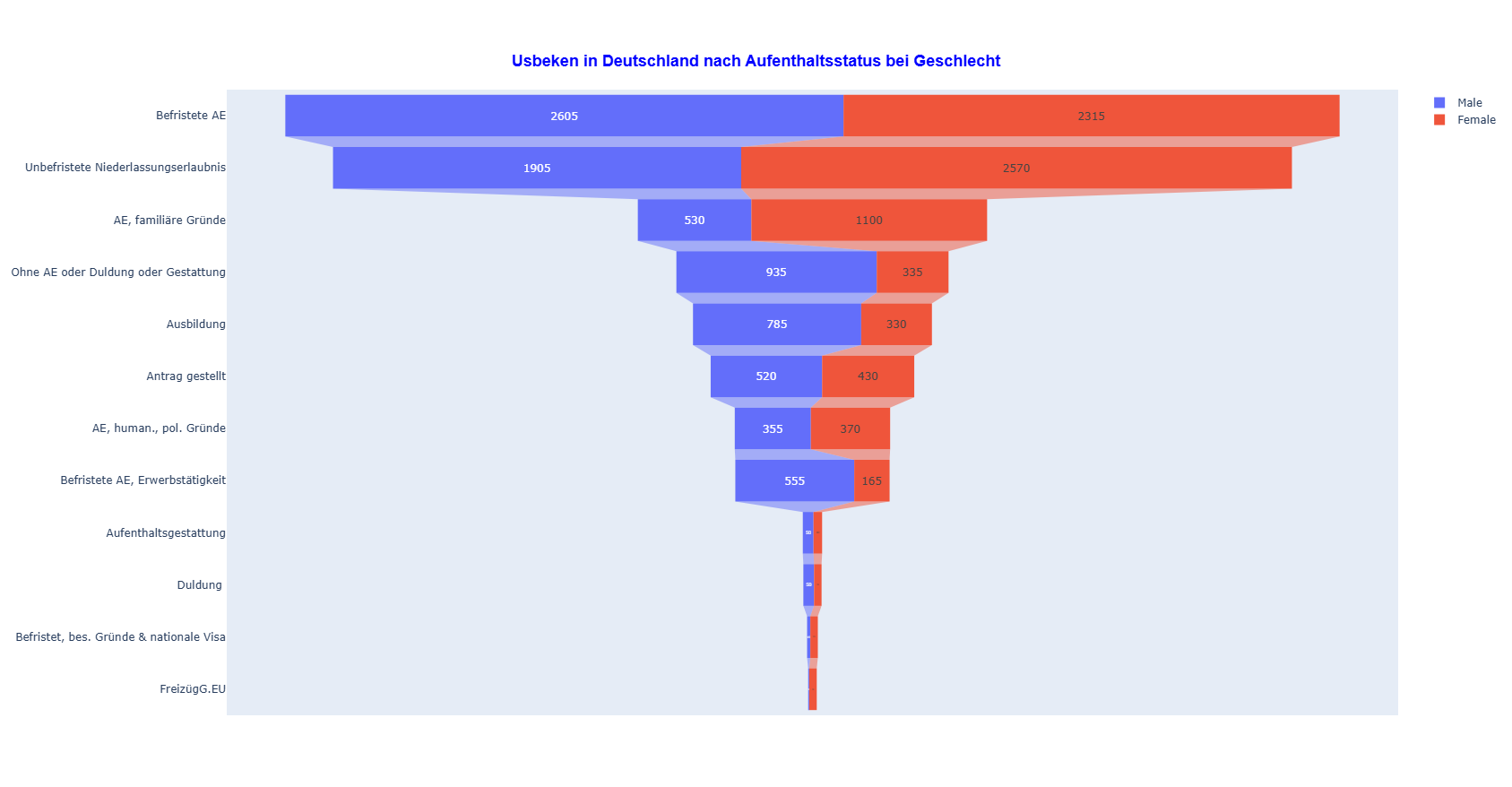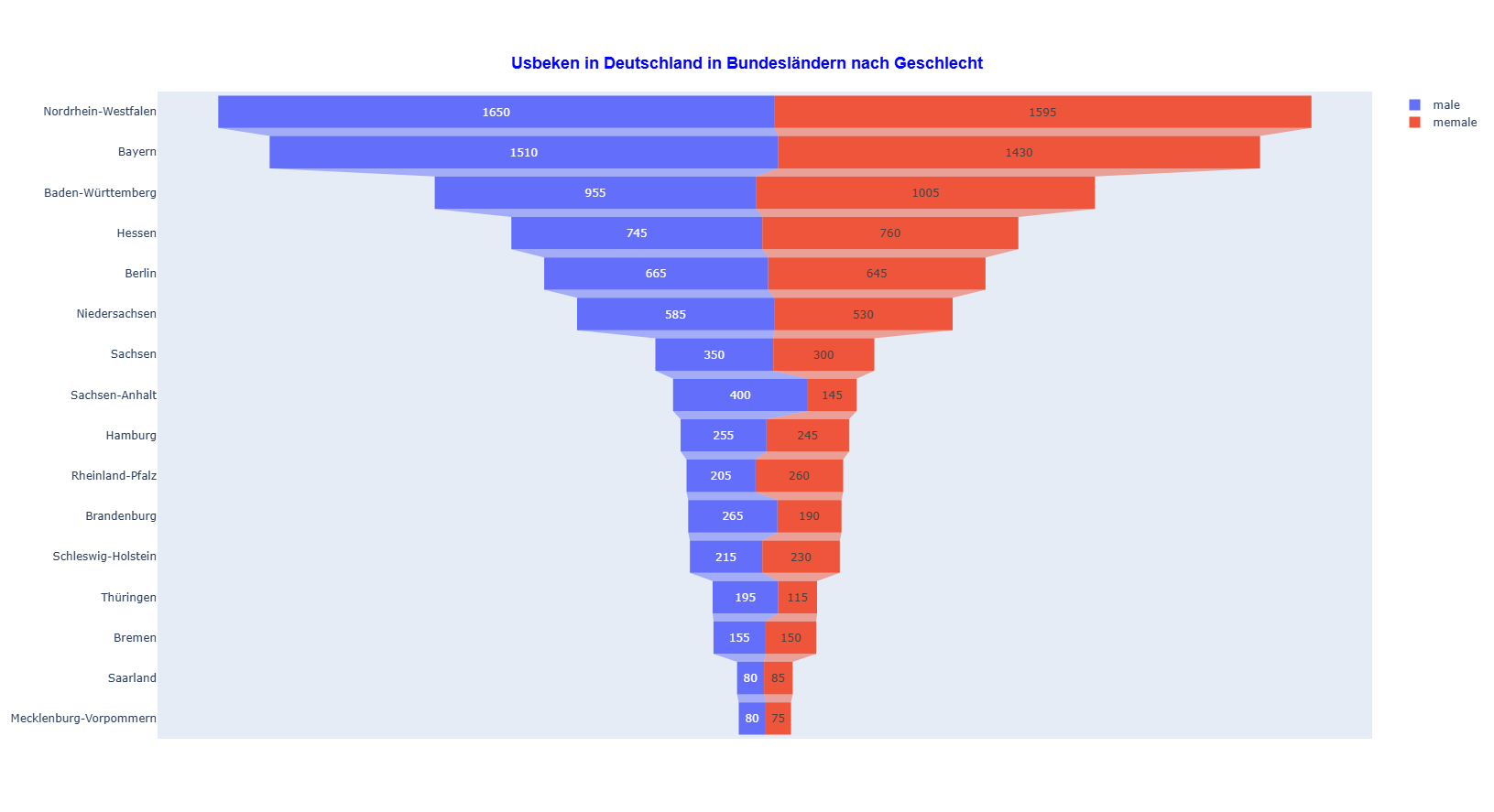| abbreviated variable name | original variable name |
|---|---|
| AE_family | AE, familiäre Gründe |
| Ausbildung | Ausbildung |
| AE_human | AE, human., pol. Gründe |
| Duldung | Duldung |
| AEgestattung | Aufenthaltsgestattung |
| Antrag | Antrag gestellt |
| Ausbildung | Ausbildung |
| Befristete_AE | Befristete AE |
| FreizügG/EU | Aufenthaltsrecht nach FreizügG/EU |
| NVisa | Befristet, bes. Gründe & nationale Visa |
| Niederlassungserlaubnis | Unbefristete Niederlassungserlaubnis |
| OhneAT | Ohne AE | Duldung oder Gestattung |
| Erwerb | Befristete AE, Erwerbstätigkeit |
Datasource: Statistisches Bundesamt | Datastorage: GitHub
variables
The long variable names have been abbreviated to simplify editing and plotting. The names in the analysis and the names in the original are shown below:
Show some sample rows
dataclean
Code
# pivot data
piv_data <-
data_raw |>
pivot_longer(
cols = !c(Bundesland, Stadt, Kreis...Landkreis),
names_to = "status",
values_to = "cnt"
) |>
select(c(1,2,4,5))
#library(stringr) # string replace, dedect
data <-
piv_data |>
rowwise() |>
mutate(
geschlecht = ifelse(
endsWith(status, "_m"), "male",
ifelse(
endsWith(status, "_w"), "female"
)
)
) |>
mutate(across("status", str_replace, "_m|_w", "")) |>
rename(
"bundesland" = "Bundesland",
"kreis" = "Stadt")
data |>
head()#> # A tibble: 6 × 5
#> # Rowwise:
#> bundesland kreis status cnt geschlecht
#> <chr> <chr> <chr> <int> <chr>
#> 1 Schleswig-Holstein Flensburg FreizügG.EU 0 male
#> 2 Schleswig-Holstein Flensburg FreizügG.EU 0 female
#> 3 Schleswig-Holstein Flensburg Niederlassungserlaubnis 0 male
#> 4 Schleswig-Holstein Flensburg Niederlassungserlaubnis 5 female
#> 5 Schleswig-Holstein Flensburg Befristete_AE 0 male
#> 6 Schleswig-Holstein Flensburg Befristete_AE 5 female
Diqqat! Achtung! Bнимание! Attention!
Columname Kreis / Landkreis mit / gespeichert. Normal R liest die Spalte so wie sie in DF gespeichrt ist, muss aber mit dplyr so angesprochen werden:
In Qarto sieht eingelesene Spaltenname Kreis / Landkreis -> Kreis...Landkreis
mapplot via ggplot
(data grouped by [Bundesländer])
Code
# libraries:
# pkg <- c("giscoR", "ggtext", "glue", "syfonts", "png", "ggimage", "fontawesome")
# lapply(pkg, library, character.only = TRUE)
# Group by bundesland ==========================================================
d_group <-
data |>
group_by(bundesland) |>
summarise(pop = sum(cnt))
# Geo data for germany =========================================================
# library(giscoR)
ger <- gisco_get_nuts(
year = 2024,
epsg = 4326,
nuts_level = 1,
resolution = "01",
country = "Germany"
)
# Merge both data ==============================================================
df_de <-
ger |>
left_join(d_group, by = c("NUTS_NAME" = "bundesland"))
# new col mit abkurzung to from bundesländer to df
L_Abk <- c("SH", "MV", "TH", "NI", "BW", "NW", "RP", "SL", "BY", "BE", "SN",
"BB", "HB", "HH", "ST", "HE")
df_de$abk <- L_Abk
# read image dop
img <- readPNG("gallery_img/dop.png")
# create mapplot
map_plt <-
ggplot(df_de) +
geom_sf(aes(fill = NUTS_NAME))+ #(aes(fill = NUTS_NAME), show.legend = FALSE) # disable legend
geom_sf_label(aes(label = paste(abk, ":", pop)), fill = "aliceblue", col = "dodgerblue4") +
geom_text(aes(y = 50.1, x =13.8, label = paste("Gesamt:", sum(pop))),
stat = "unique",
size = 3.6, size.unit = "mm", col = "dodgerblue4", fontface = "bold") +
annotate(
'rect',
xmin = 12.4,
xmax = 15.2,
ymin = 49.9,
ymax = 50.3,
alpha = 0.5,
fill = 'aliceblue',
col = 'dodgerblue4',
)+
annotation_raster(img, xmin = 6, xmax = 8, ymin = 54, ymax = 55.5, interpolate = FALSE) +
theme_minimal()+
labs(
title = "**Usbeken in Deutschland**",
subtitle = "nach Bundesländern",
caption = social_caption_map
) +
guides(fill = guide_legend(title="Bundesland")) +
theme(plot.title = ggtext::element_markdown(size = 13, color = "steelblue4", face = "bold"),
plot.subtitle = element_markdown(),
plot.caption = element_markdown(size = 11), # element_textbox_simple()
plot.caption.position = "plot", #plot, margin, panel,
legend.title = element_text(color = "darkgrey", size = 12, face = "bold"),
axis.text.x=element_blank(),
axis.text.y=element_blank(),
axis.ticks=element_blank(),
axis.title.x=element_blank(),
axis.title.y=element_blank())
map_pltbarplot via ggplot
(grouped data by [Aufenthaltsstatus])
Code
# Group by Status ==============================================================
group_stat <-
data |>
group_by(status) |>
summarise(n = sum(cnt))
# create plot ------------------------------------------------------------------
bar_plt <-
ggplot(group_stat, aes(x = n, y = reorder(n, status), fill = status))+
geom_col()+
geom_text(aes(label = n),
hjust = -0.1, color = "darkgrey", fontface = "bold")+
scale_fill_discrete(name = "Aeufenthaltsstatus", labels = legnd) +
labs(
title = "Usbeken in Deutschlan, nach Aufenthaltsstatus",
caption = social_caption_map,
x = "Zahl (k = 1000)" ) +
scale_x_continuous(
labels = function(x) paste0(x/1000, "k"),
expand = expansion(c(0.01, 0.05))) +
theme_classic() +
theme(
plot.title = ggtext::element_markdown(
size = 13, color = "steelblue4", face = "bold"),
plot.caption = ggtext::element_markdown(size = 11),
axis.title.y = element_blank(),
axis.text.y = element_blank(),
axis.line = element_line(colour = "gray"),
panel.grid.major.x = element_blank(),
panel.grid.minor.x = element_blank(),
legend.position = c(0.8, 0.40)
)
bar_pltfunnel chart via ggplot
(grouped data by [Aufenthaltsstatus])
Code
group_status <-
data |>
group_by(status, geschlecht) |>
summarise(cnt = sum(cnt)) |>
mutate(
n = case_when(
geschlecht == "female" ~ cnt*-1,
TRUE ~ cnt
)
)
brks <- c(seq(-3000, 3000, by = 500))
lbls = c(seq(30, 0, -5), seq(5, 30, 5))
p <- group_status |>
ggplot(aes(x = reorder(status, n), y = n, fill = geschlecht))+
geom_bar(stat = "identity", width = .6) +
scale_y_continuous(breaks = brks, labels = lbls) +
scale_x_discrete(labels = legnd) +
geom_label(aes(label = abs(n)), colour = "blue", fontface="bold", size=3.5) +
guides(fill = guide_legend(
title = "Geschlecht:",
override.aes = aes(label = ""))) +
coord_flip() +
labs(title="Usbeken in Deutschland nach Aufenthaltsstatus",
caption = social_caption_map
) +
theme_minimal() +
theme(plot.title = ggtext::element_markdown(
size = 13, color = "steelblue4", face = "bold"),
plot.caption = ggtext::element_markdown(size = 11),
axis.title.x = element_blank(),
axis.text.x = element_blank(),
axis.title.y = element_blank(),
axis.ticks = element_blank(),
panel.grid.major.x = element_blank(),
panel.grid.minor.x = element_blank(),
legend.background = element_rect(),
legend.position = "top")
pfunnel chart via ggplot
(grouped data by [Aufenthaltsstatus])
Code
group_bl <-
data |>
group_by(bundesland, geschlecht) |>
summarise(cnt = sum(cnt)) |>
mutate( # einen Teil die Daten musste ich negativ machen,
n = case_when( # weil sons stacked bar wurde
geschlecht == "female" ~ cnt*-1,
TRUE ~ cnt
)
)
group_bl |>
ggplot(aes(x = reorder(bundesland,n), y = n, fill = geschlecht))+
geom_bar(stat = "identity", width = .6) +
scale_y_continuous(breaks = brks, labels = lbls) +
geom_label(aes(label = abs(n)), colour = "floralwhite", fontface="bold", size=4) +
guides(fill = guide_legend(
title = "Geschlecht:",
override.aes = aes(label = ""))) +
coord_flip() +
labs(title="Usbeken in Deutschland nach Geschlecht in Bundesländern") +
theme_minimal() +
theme(plot.title = ggtext::element_markdown(
size = 13, color = "steelblue4", face = "bold"),
plot.caption = ggtext::element_markdown(size = 11),
axis.title.x = element_blank(),
axis.text.x = element_blank(),
axis.title.y = element_blank(),
panel.grid.major.x = element_blank(),
panel.grid.minor.x = element_blank(),
legend.background = element_rect(),
legend.position = "top")prepare date (use data from R)
group by [status] in pandas
show the code
import numpy as np
import pandas as pd
from IPython.display import display, Markdown, HTML
var_name = {"AE_family": "AE, familiäre Gründe",
"Ausbildung": "Ausbildung ",
"AE_human": "AE, human., pol. Gründe",
"Duldung": "Duldung ",
"AEgestattung": "Aufenthaltsgestattung",
"Antrag": "Antrag gestellt",
"Ausbildung": "Ausbildung",
"Befristete_AE": "Befristete AE",
"FreizügG/EU": "Aufenthaltsrecht nach FreizügG/EU",
"NVisa": "Befristet, bes. Gründe & nationale Visa",
"Niederlassungserlaubnis": "Unbefristete Niederlassungserlaubnis",
"OhneAT": "Ohne AE oder Duldung oder Gestattung",
"Erwerb": "Befristete AE, Erwerbstätigkeit"}
df_r = pd.DataFrame(r.group_status)
# rename rownames
def replace_rname(name):
return var_name.get(name, name)
df_r["status"] = df_r["status"].apply(replace_rname)
# pivot wide
data = df_r.pivot(index = "status", columns = "geschlecht", values = "cnt").reset_index()
summa = np.abs(data.female + data.male)
data["summa"] = summa
df = data.copy()
df = df.sort_values(
"summa",
ascending=False,
inplace=False,
ignore_index=False,
key=None
)
female = df.female
male = df.male
labels = df.status
Markdown(df.to_markdown(index = False))| status | female | male | summa |
|---|---|---|---|
| Befristete AE | 2315 | 2605 | 4920 |
| Unbefristete Niederlassungserlaubnis | 2570 | 1905 | 4475 |
| AE, familiäre Gründe | 1100 | 530 | 1630 |
| Ohne AE oder Duldung oder Gestattung | 335 | 935 | 1270 |
| Ausbildung | 330 | 785 | 1115 |
| Antrag gestellt | 430 | 520 | 950 |
| AE, human., pol. Gründe | 370 | 355 | 725 |
| Befristete AE, Erwerbstätigkeit | 165 | 555 | 720 |
| Aufenthaltsgestattung | 40 | 50 | 90 |
| Duldung | 35 | 50 | 85 |
| Befristet, bes. Gründe & nationale Visa | 35 | 15 | 50 |
| FreizügG.EU | 35 | 5 | 40 |
plot by [status] with plotly
show the code
from plotly import graph_objects as go
fig = go.Figure()
fig.add_trace(go.Funnel(
name = 'Male',
y = list(labels),
x = list(male),
textinfo = "value"))
fig.add_trace(go.Funnel(
name = 'Female',
orientation = "h",
y = list(labels),
x = list(female),
textposition = "inside",
textinfo = "value"))
fig.update_layout(
title='<b>Usbeken in Deutschland nach Aufenthaltsstatus bei Geschlecht</b>',
title_font=dict(size=18,
color='blue',
family='Arial'),
title_x=0.50, # Title aligned with grid
title_y=0.93 # Title positioned near the top vertically
)
#fig.show()
print(fig)
#fig.write_image("gallery/plots/fig1.png")
#plotly.offline.plot(fig, filename='gallery/plots/fig1.png', image='png')group by [bundesland]
show the code
import numpy as np
import pandas as pd
from IPython.display import display, Markdown, HTML
# load R data
df_bl_r = pd.DataFrame(r.group_bl)
# pivot wide
data_bl = df_bl_r.pivot(index = "bundesland", columns = "geschlecht", values = "cnt").reset_index()
sum_bl = np.abs(data_bl.female + data_bl.male)
data_bl["summa"] = sum_bl
df_bl = data_bl.copy()
df_bl = df_bl.sort_values(
"summa",
ascending=False,
inplace=False,
ignore_index=False,
key=None
)
# vars for plot
fem = df_bl.female
mal = df_bl.male
lab = df_bl.bundesland
Markdown(df_bl.to_markdown(index = False))| bundesland | female | male | summa |
|---|---|---|---|
| Nordrhein-Westfalen | 1595 | 1650 | 3245 |
| Bayern | 1430 | 1510 | 2940 |
| Baden-Württemberg | 1005 | 955 | 1960 |
| Hessen | 760 | 745 | 1505 |
| Berlin | 645 | 665 | 1310 |
| Niedersachsen | 530 | 585 | 1115 |
| Sachsen | 300 | 350 | 650 |
| Sachsen-Anhalt | 145 | 400 | 545 |
| Hamburg | 245 | 255 | 500 |
| Rheinland-Pfalz | 260 | 205 | 465 |
| Brandenburg | 190 | 265 | 455 |
| Schleswig-Holstein | 230 | 215 | 445 |
| Thüringen | 115 | 195 | 310 |
| Bremen | 150 | 155 | 305 |
| Saarland | 85 | 80 | 165 |
| Mecklenburg-Vorpommern | 75 | 80 | 155 |
plot by [bundesland] with plotly
show the code
from plotly import graph_objects as go
import plotly.io as pio
#import plotly
# import plotly.io as pio
# png_renderer = pio.renderers["png"]
# png_renderer.width = 500
# png_renderer.height = 500
#
# pio.renderers.default = "png"
fig_bl = go.Figure()
fig_bl.add_trace(go.Funnel(
name = 'male',
y = list(lab),
x = list(mal),
textinfo = "value"))
fig_bl.add_trace(go.Funnel(
name = 'memale',
orientation = "h",
y = list(lab),
x = list(fem),
textposition = "inside",
textinfo = "value"))
fig_bl.update_layout(
title='<b>Usbeken in Deutschland in Bundesländern nach Geschlecht</b>',
title_font=dict(size=18,
color='blue',
family='Arial'),
title_x=0.50, # Title aligned with grid
title_y=0.93 # Title positioned near the top vertically
)
# # show as static img
# fig_bl.show(renderer="png")
# # write as image
# pio.write_image(fig_bl, "C:/Users/sultanov/Documents/blog/gallery/plots/figname.png") 





